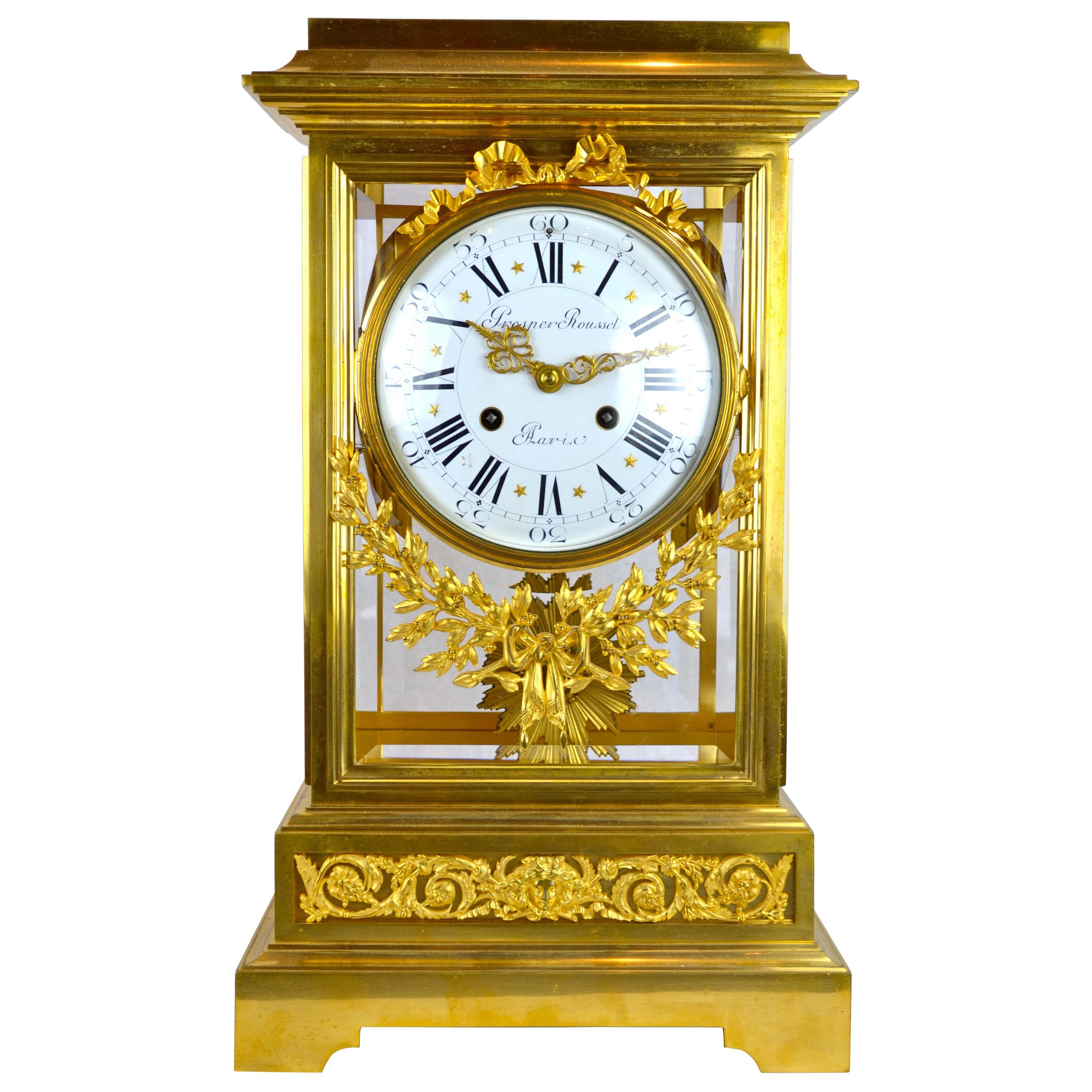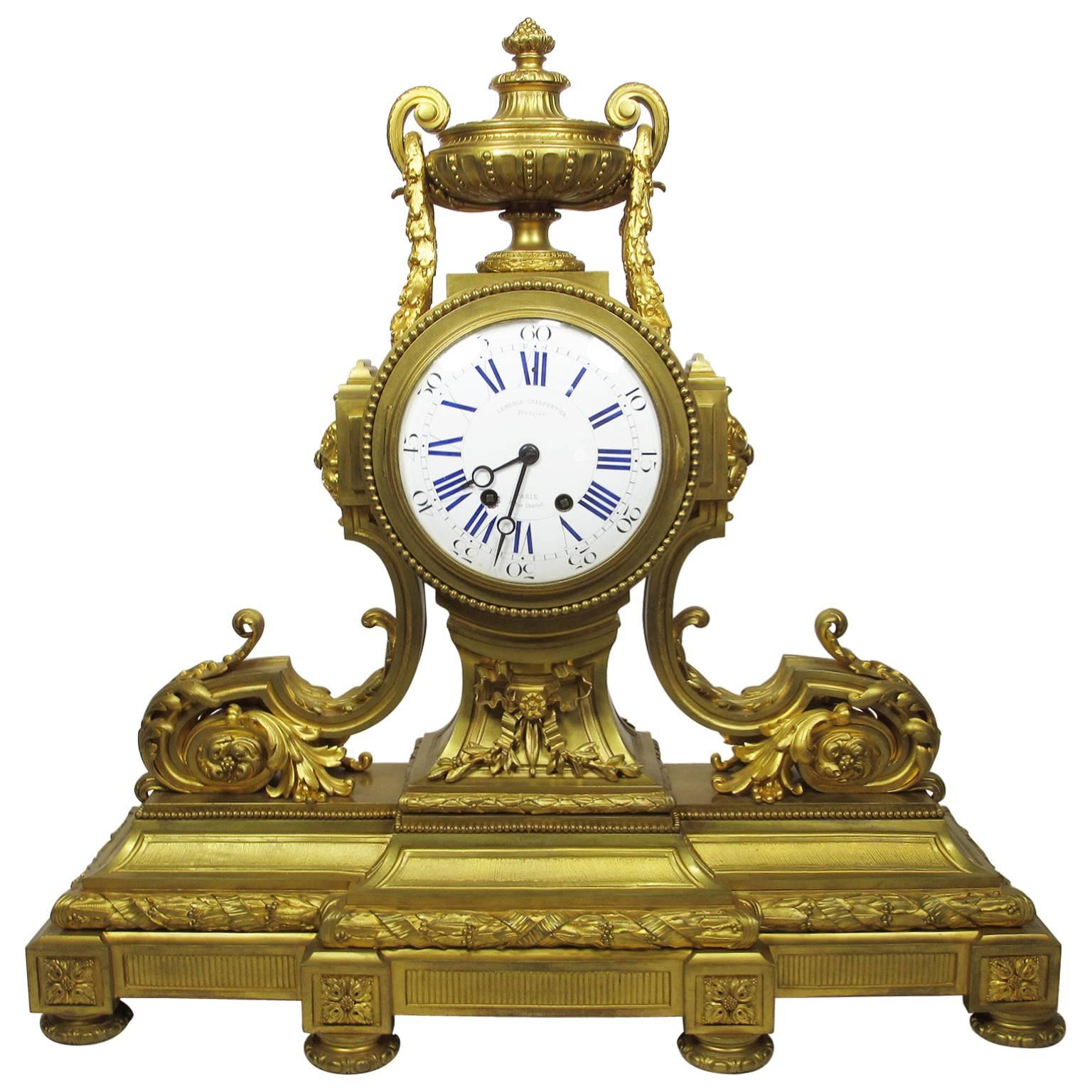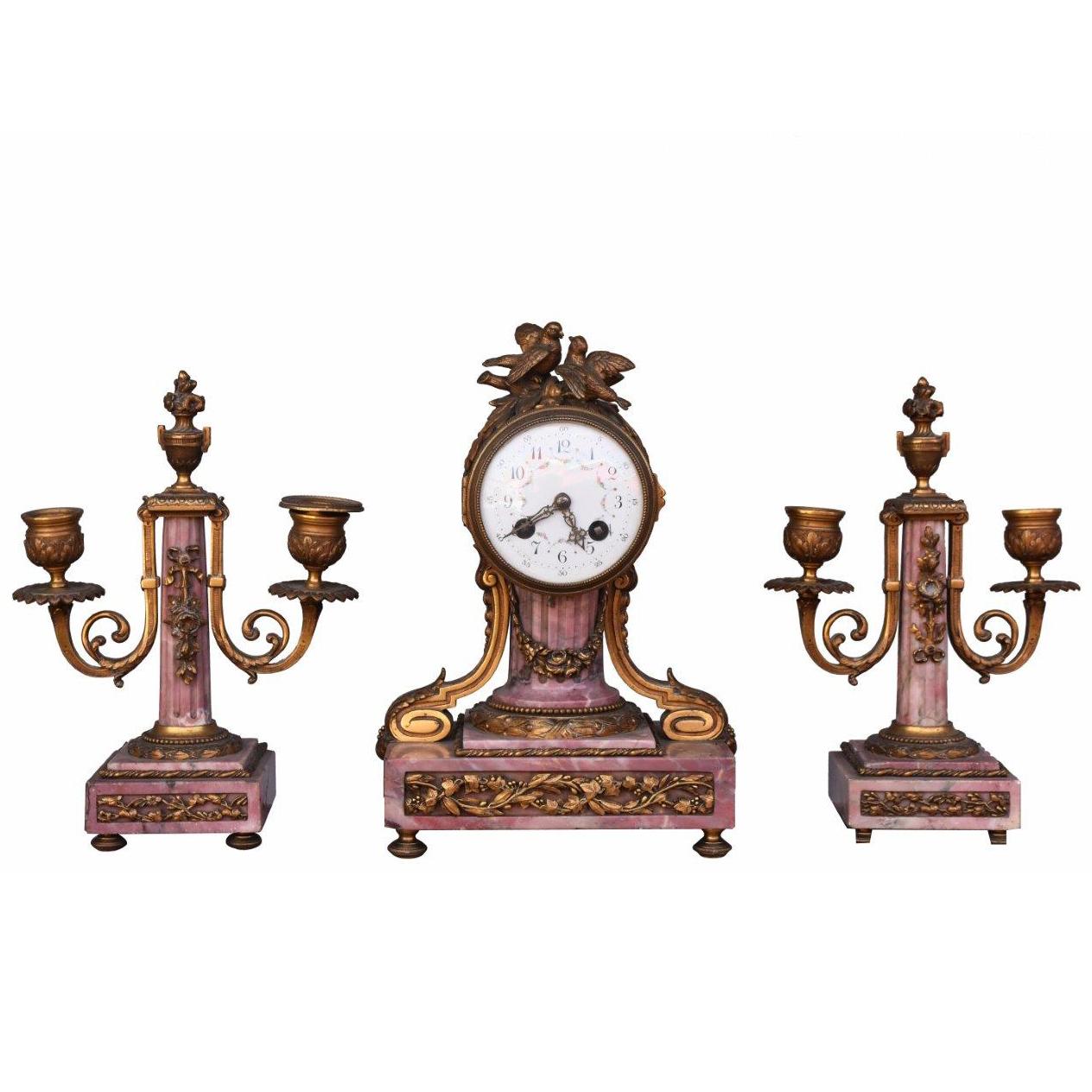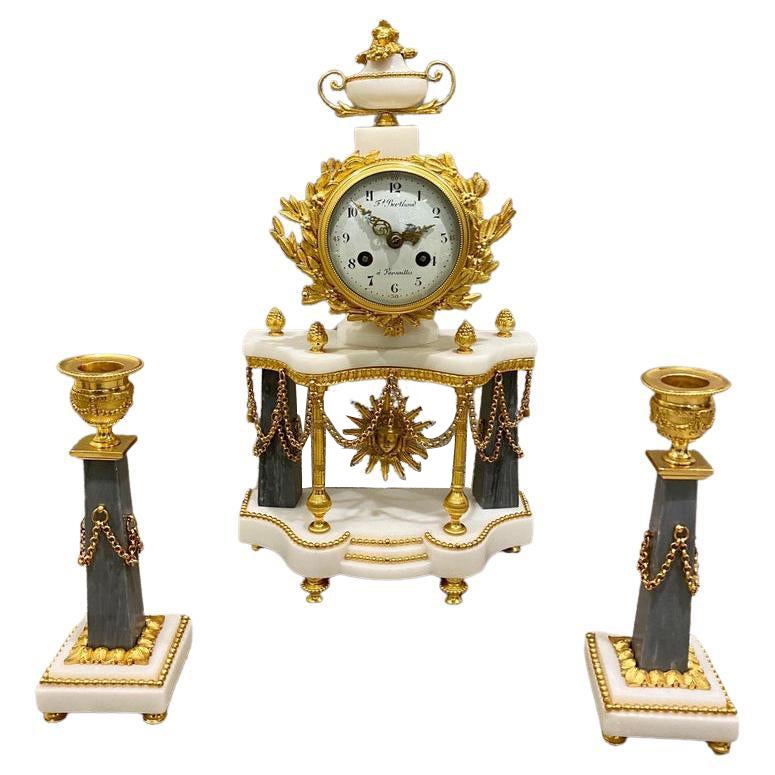Items Similar to 19th Century Louis XVI Style Regulator Gilt Bronze Clock by Ferdinand Berthoud
Want more images or videos?
Request additional images or videos from the seller
1 of 12
19th Century Louis XVI Style Regulator Gilt Bronze Clock by Ferdinand Berthoud
About the Item
A stunning 19th Century Louis XVI Style Regulator Gilt Bronze clock by Ferdinand Berthoud.
A French Louis XVI style gilt bronze regulator clock, the finely cast rectangular case with four beveled glass sides; the large white enamel dial with Roman numerals is decorated above and below with gilt bronze garlands. The dial is signed and the stepped base is further embellished on three sides with a gilded frieze with central Apollo mask. The steel string suspension movement ringing the hours and halves on a bell; the movement has a large star burst pendulum.
- Dimensions:Height: 19.69 in (50 cm)Width: 11.82 in (30 cm)Depth: 7.88 in (20 cm)
- Materials and Techniques:
- Place of Origin:
- Period:
- Date of Manufacture:19th Century
- Condition:Wear consistent with age and use.
- Seller Location:Southall, GB
- Reference Number:1stDibs: LU5808231952072
About the Seller
5.0
Vetted Seller
These experienced sellers undergo a comprehensive evaluation by our team of in-house experts.
Established in 1956
1stDibs seller since 2021
41 sales on 1stDibs
Typical response time: <1 hour
- ShippingRetrieving quote...Ships From: LONDON, United Kingdom
- Return PolicyA return for this item may be initiated within 3 days of delivery.
More From This SellerView All
- Louis XV Style 19th Century French Figural Gilt Bronze Mantel ClockLocated in Southall, GBLouis XV style 19th century French figural gilt bronze mantel clock. The enamel dial with Roman numerals and foliate pierced gilt hands. Signed Deniere A Paris...Category
Antique 19th Century French Mantel Clocks
MaterialsBronze
- English Bracket Clock, 19th CenturyLocated in Southall, GBA fine quality 19th century English bracket clock of the Georgian era. The classical styled numerals and gilt topped case are surmounted by a floral sculpture. Marked on the face 'Le...Category
Antique 19th Century European Mantel Clocks
MaterialsBronze
- 19th Century French Wall Clock In Lapis Lazuli By Paul SormaniBy Paul SormaniLocated in Southall, GBElegant wall clock by Paul Sormani, in blue lapis lazuli and gilt bronze ormolu. Paul Sormani was a famed French 19th century cabinetmaker, renown for his production of magnificent...Category
Antique Mid-19th Century French Louis XIV Wall Clocks
MaterialsLapis Lazuli
- French Rosewood and Boxwood Cased Wall Clock, 19th CenturyLocated in Southall, GBA French rosewood and boxwood cased wall clock, second quarter of the 19th century. The 6" diameter white enamel dial with roman numerals, within an ei...Category
Antique 19th Century French Wall Clocks
MaterialsWood, Boxwood, Rosewood
- Early 18th Century Francis Gregg English Bracket ClockLocated in Southall, GBFrancis Gregg, London. A fine table clock. The break arch brass dial with silvered chapter ring, matted centre, calendar aperture and false pendulum aperture with silvered cartouche ...Category
Antique Early 18th Century English Mantel Clocks
MaterialsWood
- 19th Century Large Bronze AngelLocated in Southall, GBA beautiful 19th century large bronze angel with wonderfully aged patina. Perfect as garden furniture or home decoration.Category
Antique 19th Century English Statues
MaterialsBronze
You May Also Like
- 19th Century Louis XVI Style Regulator Gilt Bronze Clock by Prosper RousselLocated in Vancouver, British ColumbiaA French Louis XVI style gilt bronze regulator clock, the finely cast rectangular case with four beveled glass sides; the large white enamel dial with Roman numerals is decorated above and below with gilt bronze garlands. The dial is signed Prosper Roussel...Category
Antique Mid-19th Century French Louis XVI Mantel Clocks
MaterialsBronze
- Mantel Clock 19th Century Styl Empire by Ferdinand Berthoud À ParisLocated in Warsaw, PLOrmolu bronze mantel clock flanked by a troubadour and musical instruments, signed 'Ferdinand Berthoud a Paris'. The end of the 18th and beginning of the 19th century was a crucial time in which new technological advances helped to make watches more accurate and more portable. During the 1790s, the production of gilded bronze increased considerably as working conditions improved. The freedom of trade initiated by the French Revolution allowed many casters to develop large factories. The new factory environment gave them a chance to execute all stages of bronze work including drawing, casting, gilding, assembly, and trade of art objects. While the bronzers took creative liberty in creating all kinds of clocks in contrast to the noble and rigorous structure carried by the movement of neoclassicism. Under the reign of Empire, the case designs started gradually to develop away from a proportionate and strict classicism towards a baroque style and revival style. The rediscovery of medieval civilization was one of the intellectual curiosities of the beginning of the 19th century, with much input from the Ancien Régime and its institutions, rites and the medieval churches in which family ceremonies occurred. This early nineteenth-century figural mantel clock is surmounted by a medieval musician. To be more precise, it is a french troubadour. Troubadours were known for composing and performing lyric poetry for the nobility back during medieval times. The clock is featuring a chiselled bronze troubadour, dressed in medieval fashion while holding a flute, playing a tune from sheet music called "Du Troubadour" that is resting on top of the rectangular clock case. In addition to that, the clock features a gilt bronze lute or vielle resting on a small stool on the opposite side of the clock’s case. The white enamel dial features the inscription Berthoud and is underlined by a bronze entourage chiselled with palmette motif, plus encompassed by c-scrolls and wreaths. The original hands are in blued steel and encircled by Roman numerals indicating hour next to Arabic numerals indicating minutes. The small details that adorn the hexagonal plinth are reliefs, depicting two water fountains or basins on both sides with a lyre in between. The sculpted image of a lyre raised above the background features also foliage garlands tied on top with ribbons. The clock rests on seven spinning feet. The clock was made in the well-known workshop of the Berthoud’s family that was recognized for their excellent work by the King. Berthoud Clockmakers History. Ferdinand Berthoud was a horologist and author of extensive treatises on timekeeping as well as a Swiss clockmaker serving the king of France, that produced many marine clocks, including a weight-driven version that inspired the first American sea-going clock. He was born in Plancemont, Switzerland, the son of an architect and judiciary. In 1741 he began a three-year apprenticeship as a clockmaker under his brother, Jean-Henri. He made his first marine chronometer in 1754 (sent for trial in 1761) and in 1764 was appointed a member of the Royal Society, London and Horloger Mécanicien de Sa Majesté et de la Marine ayant l'inspection de la construction des Horloges Marines. In 1769, Ferdinand Berthoud sent for his nephew Pierre-Louis Berthoud (1754–1813), commonly known as Louis Berthoud, a talented young watchmaker and clockmaker, inviting him to come to Paris from Couvet, Switzerland, to pursue his apprenticeship. Louis helped Ferdinand manufacture and repair the sea clocks...Category
Antique Late 18th Century French Louis XVI Mantel Clocks
MaterialsBronze
- 19th Century Louis XVI Style Gilt Bronze Mantel Clock by Lemerle CharpentierBy Lemerle Charpentier 1Located in Los Angeles, CAA Palatial French 19th century Louis XVI style gilt bronze mantel clock by Lemerle-Charpentier bronzier. The large rectangular gilt bronze body surmounted with floral scrolls and aca...Category
Antique 19th Century French Louis XVI Mantel Clocks
MaterialsBronze
- Antique French Louis XVI Style Gilt Bronze Wall Clock, 19th CenturyLocated in Dallas, TXCrafted in France in the 1800s, this high quality gilt bronze wall clock has elements in the style of Louis XVI. The white clock face with blue numbers re...Category
Antique 19th Century French Louis XVI Wall Clocks
MaterialsMetal, Bronze
- 19th Louis XVI Style Marble Mantel Clock with Gilt BronzeLocated in Marseille, FR19th Louis XVI style marble mantel clock with gilt bronze.Category
Antique 1890s French Louis XVI Mantel Clocks
MaterialsMarble, Bronze
- Ferdinand Berthoud. Louis XVI Ormolu Mounted Marble 3 Piece Clock Set 1770By Ferdinand BerthoudLocated in London, GBA very fine Louis XVI ormolu clock set, by Ferdinand Berthoud, Paris, circa 1770 This clock set is presented in gilt Bronze and Bleu Turqin and...Category
Antique 1770s French Louis XVI Mantel Clocks
MaterialsMarble, Bronze, Iron





